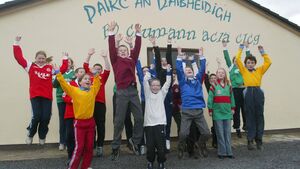Rural decline is decimating many GAA clubs

Schoolchildren are pictured at Davitt Park in Achill Sound in 2003. Picture: INPHO/Lorraine O'Sullivan
Cuala’s success in winning the All-Ireland Senior Club Football title was very well received in Mayo, as they were managed by Louisburgh’s Austin O’Malley.
O’Malley is one of the good guys in Mayo GAA and is a manager with considerable potential so his role in Cuala’s success is not just a source of pride to people from Mayo but also a source of hope for what he could do with Mayo in time.
However, while I was pleased for Austin, I couldn’t help but look at the All-Ireland football and hurling club finals from a demographics point of view. Cuala won the football and another big Dublin club, Na Fianna, won the hurling.
It is possible to laud their achievements while also expressing concerns about numbers. Both clubs are what are known as ‘superclubs’, clubs with 3,000 members or more.
It is a staggering resource of people to have access to for players, coaches and officials. There’s an argument to be had about how big clubs should be allowed to become in an association where they were developed around the parish when parishes were, across the board, much smaller in population than many clubs have grown to now.
By way of comparison, no club in Mayo has close to that number of members. Indeed, the vast, vast majority of clubs in our county would draw from a population of less than 3,000, never mind a membership of 3,000. Castlebar Mitchels and Westport have grown considerably in recent seasons and have put together great structures and are reaping the rewards of a lot of hard work.
But, while they are a long way off ‘superclub’ status, the size of their clubs and population bases compared to rural clubs in this county is a source of concern. It is further proof of how the fabric of the GAA is changing before our eyes, urban clubs getting bigger and many rural clubs struggling to survive or going to the wall with the conjoined forces of rural depopulation and urbanisation.
These are massive issues for the GAA but also on a much broader level for our country as the nature of our society is transforming. However, it would seem not everyone is in agreement.
Writing in the on January 14 last, Dr Richard Martin penned a piece arguing that there is no decline in rural Ireland. Perhaps he was being deliberately contrarian but it came across as misinformed.
It was about an issue of grading at junior championship level where junior clubs opposed a motion from Westport to allow B teams to compete for the junior championship but such discussions always broach wider debates.
Both in the and in the All-Ireland Whingers Podcast before Christmas, Dr Martin admonished junior clubs like Achill and Ballycroy, who spoke against the motion, for their 'crying and moaning', entirely oblivious to how rural areas like them (and they are far from the only ones) are really struggling.
According to Dr Martin, rural Ireland is in rude health.
“Is rural Ireland in decline? We are a country at full employment. We have Allergan, Baxter, Coca Cola, Hollister, Fort Wayne Metals all embedded in our county. We are not living in the 1950s anymore where there was no future, and the only future was the boat to England,” Dr Martin wrote in the .
Perhaps it has escaped Dr Martin’s attention that just because people do not remain in a place where there is no work for them does not mean there is no decline in rural Ireland.
Connectivity to the world has improved but emigration is still a huge part of the reality for many communities on the periphery of our county. These are issues that have been well ventilated and there is plenty of evidence to support it.
Indeed, as it happens, clubs in rural Mayo were in much finer fettle in the 1950s. The Mayo All-Ireland winning team of 1951 featured three players from North Mayo clubs currently at junior. There was Tom Langan from Ballycastle, Paddy Irwin from Lacken and Joko Gilvarry from Killala. It would be a shock to see any player from those clubs start on a Mayo team now, so ravished have they been by depopulation, and so unviable have the numbers become in those parishes.
So much so that those three clubs are part of a four-club underage amalgamation (together with Kilfian) as Naomh Padraig.
Lacken, with their critical mass so diminished, no longer field in their own right at adult level and have formed a ‘co-operation’ with Kilfian as Northern Gaels for the last two seasons. It seems inevitable that a formal, permanent amalgamation will take place.
Dr Martin spoke about 'culture' in clubs. It is certainly a factor.
Ballintubber have shown what can happen when you get a talented group with the right direction as they swept to five county senior titles from 2010-19.
But Ballintubber are concerned for their future too. While the club was still intermediate, Ballintubber stalwarts were expressing grave concerns for the future when they looked at their school numbers.
Culture can only get you so far when your numbers are falling through the floor.
John McAndrew, midfielder on the 1951 team, was from the parish of Kiltane. They were a proud senior club for 40 unbroken seasons from 1974 to 2012 with a culture of staying there. The late John Noel Carey had a great line: ‘You should only win the intermediate once’, that is to say you should stay senior once you get up.
But defiance and attitude will only get you so far when the tide of numbers is going in one direction. In 1994, the three national schools in the parish had a combined enrolment of 336 pupils. Now? Exactly one third, 112.
Dr Martin opined that the fact Achill are a junior club ‘is a disgrace’, claiming they should be ‘minimum at intermediate’, adding ‘in all my time playing against Achill, I never met a good team’.
Having witnessed the reality for footballers in Achill since I moved here a decade ago and having had a reasonable understanding of it before then, Achill being intermediate would be a fine achievement. I know of no place in Mayo as impacted by emigration as Achill. It has been a sad way of life for the parish for generations.
In 1965, Achill won the Minor A county title. However, they could not translate that to senior success. Too many of their brightest and best had to leave.
The pattern of seasonal migration from the island and the Currane peninsula was well-established by then. Their famous Scanlon Cup, with six strong village teams from the parish, was played from January to Easter when the greatest number of players were around to play. They would be gone in the summer, typically engaged in seasonal, agricultural-based migration to the UK.
“In those years we could have been senior but for emigration. We lost so many good footballers,” said Pat Kilbane, a member of that 1965 team and a man who has the rare distinction of playing championship for Mayo at minor and senior grades in the same year (1965).
Emigration and migration is still a huge factor. Very few of the club’s adult footballers get to live locally. The work just isn’t there. That they continue to commute home to play shows their grá for their home club.
Dr Martin spoke about the ‘massive sacrifices’ you’ve to make if you want to be successful, citing players from his own club Castlebar Mitchels coming down from Galway for training when they were chasing an All-Ireland club title.
I’m not sure any of those players would consider that a sacrifice themselves and I am sure players from clubs a long way from senior contention like Kiltane, Ballycastle, Ballycroy and Achill who frequently fly home from overseas would chuckle at that.
On the podcast, Dr Martin cited Kerry great Pat Spillane, from the small club of Templenoe in South Kerry. He said he never heard him ‘crying about his club’, that he just ‘got on with it’.
Spillane did ‘cry’ about depopulation though. As a government-appointed ‘ambassador for rural Ireland’, he was officially tasked with tackling the issue and has frequently written about how depopulation is ravaging clubs around the country, including his own, Templenoe. He hasn’t just ‘got on with it’, he has spoken of the reality of the problem.
Communities in rural Ireland are being decimated. The numbers are there to prove it. Clubs can make marginal improvements themselves but they are right to have grave concerns about where their club will find themselves in a generation’s time, or less. And it should not just be those clubs who are concerned.





